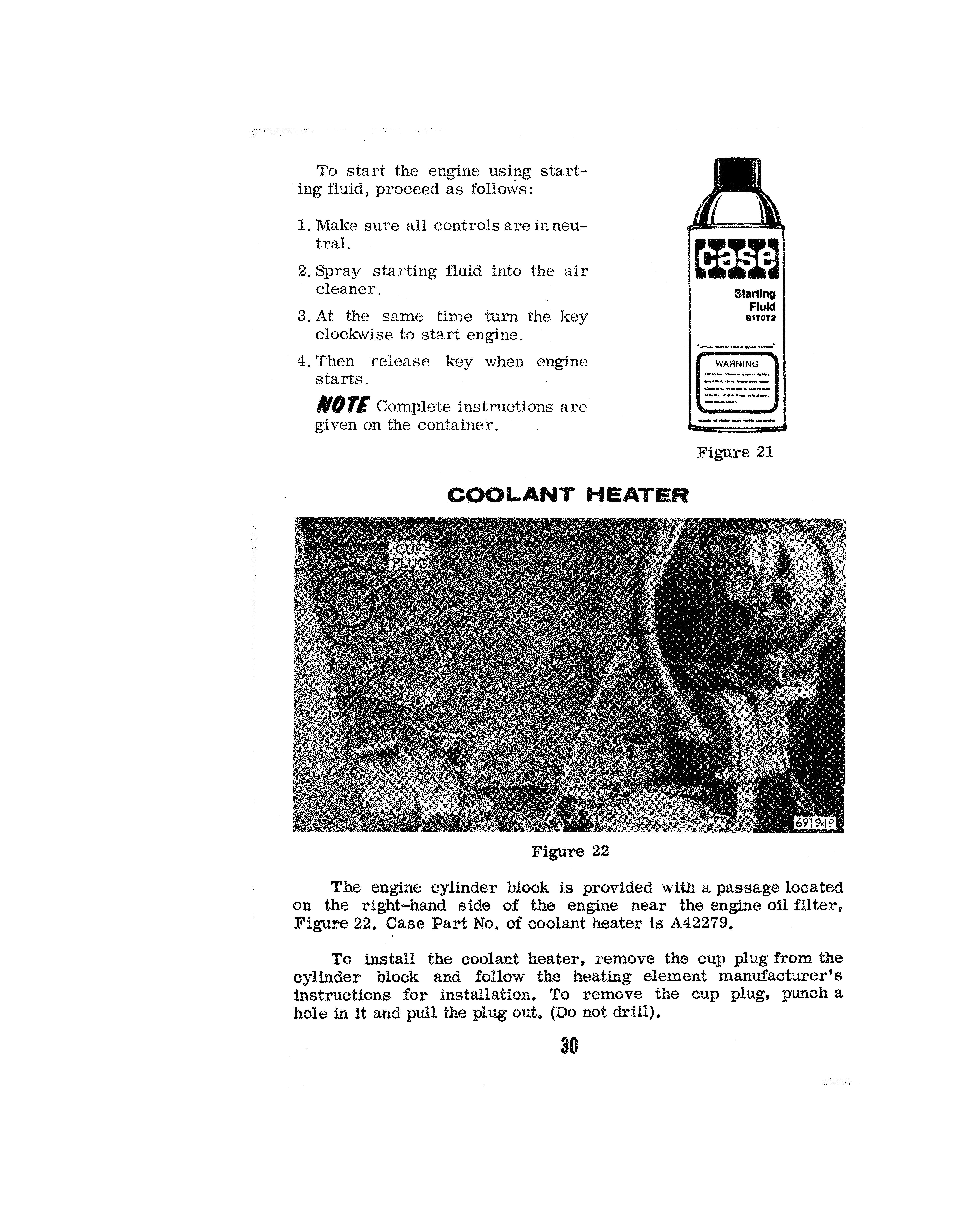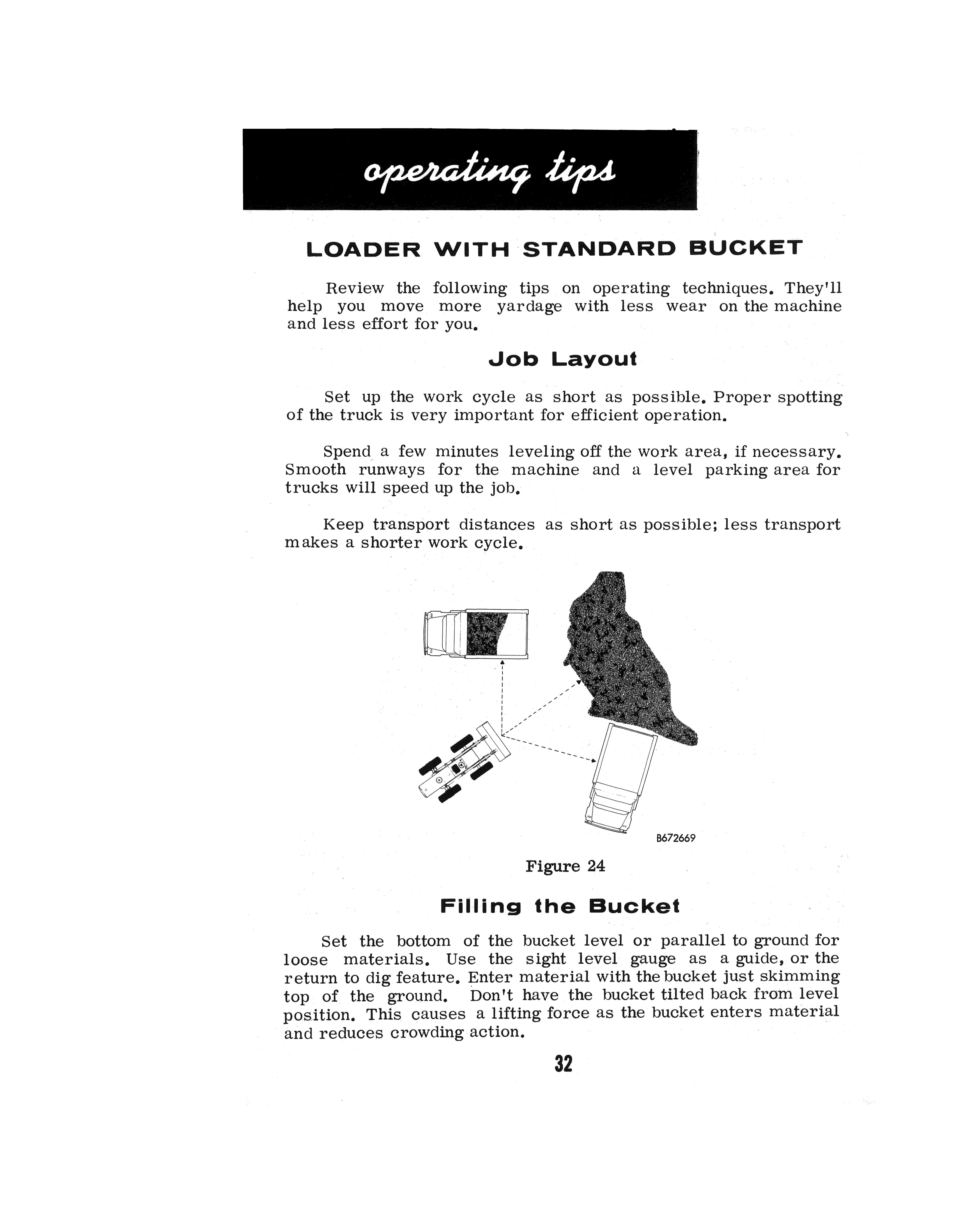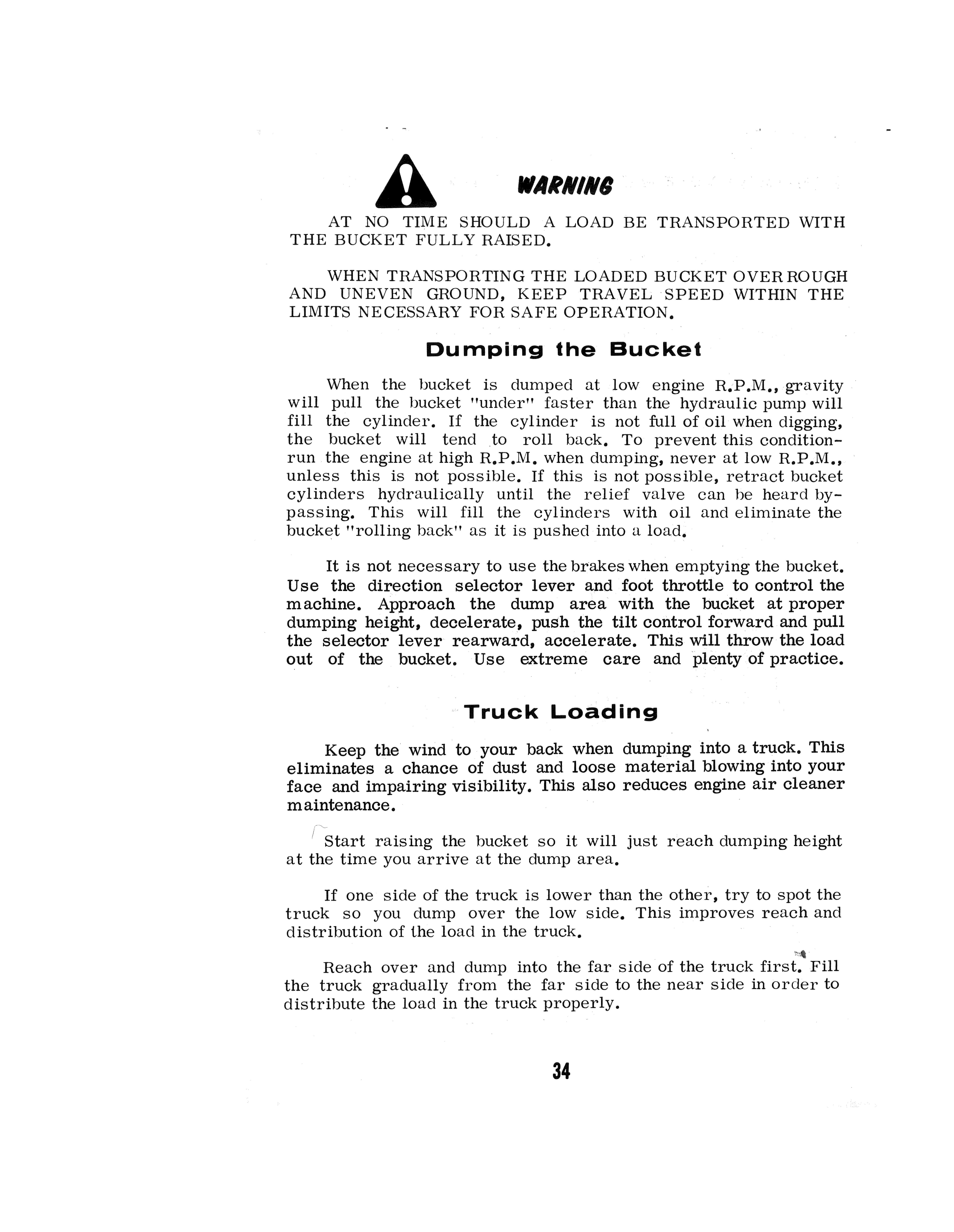
8 minute read
Loader With Drott 4-in-1 Bucket
STARTING PROCEDURE
To start the engine of the Loader, place all the controls in neutral. Depress the accelerator pedal half way and push the fuel stop lever all the way in. Pull out the choke control (gasoline only). Turn the key switch fully clockwise until the engine starts. Release the key. ' 1. Immediately check the oil pressure gauge for low or no oil pressure and the ammeter for no charging rate. If .either of these conditions are present stop the engine and investigate.
2. If the engine fires and stops, wait for the starting motor to stop spinning before again turning the key switch to start.
3. Do not use the starting motor longer than 30 seconds without interruption. Wait at least 3 minutes so batteries can recuperate and the starting motor can cool.
110 TE While the Diesel engine is being turned over with the key switch, white or black exhaust smoke should be observed. If none is observed and and the engine will not start, it is an indication that no fuel is being delivered to the cylinders.
STOPPING PROCEDURE
DIESEL ENGINE
Release accelerator pedal for engine to reach idle and pull the Shutoff lever all the way out. The shutoff lever must be all the way in to restart the engine.
SPARK IGNITION ENGINE
Depress the accelerator pedal to accelerate the engine to approximately 1200 RPM to bleed dry the carburetor idle system, then turn the key switch to the off position to actuate the solenoid shutoff on the carburetor to cut off the fuel supply. This will stop engine and prevent an after run.
COLD WEATHER OPERATION
To start and operate your Case Loader during cold weather, the following precautions must be observed:
27
1. BATTERIES - Storage batteries must be fully charged.
2, FUEL RECOMMENDATIONS - Refer to pages 44 and 45,
3, CRANKCASE OIL - The oil in the crankcase must be of the recommended viscosity.
4. TRANSMISSION AND CONVERTER OIL - Always use Case TCH oil. Both winter and summer.
5. HYDRAULIC RESERVOffi OIL - Always use Case TCH oil. Both winter and summer.
6. COOLING SYSTEM - Must be protected by a reputable brand of "High Boiling Point" type anti-freeze.
7. STOPPING THE ENGINE - Always allow the engine to reach operating temperature before stopping it. If the engine has been working under load, aJways idle the engine for a few minutes before stopping it so the engine parts can cool evenly.
8. CONDENSATION IN FUEL TANK - Always fill the fuel tank at the end of the day's operation to prevent the tank from "sweating" and water entering the fuel.

9. FUEL TANK WATER TRAP - Drain the fuel tank water trap daily to prevent any accumulation of water from freezing and causing possible damage to the water trap or the fuel tank due to expansion.
IAIJTION
NEVER IDLE THE ENGINE FOR PROLONGED PERIODS OF TIME!
DURING EXTREMELY COLD WEATHER, WATCH THE COOLANT TEMPERATURE CAREFULLY AND NEVER OPERATE THE ENGINE FOR PROLONGED PERIODS BELOW THE RECOMMENDED TERMPERATURE (ABOVE 180° F.).
During extremely cold temperatures, the engine will not warm up to, or maintain the operating temperature at low engine speeds. Low idling speeds during extremely cold temperatures will result in incomplete combustion, heavy formations on the valve system and possible serious damage to the engine.
28
1. ENGINE WARM UP PROCEDURE
A. Close the radiator shutters (if so equipped) or cover the radiator.
B. Start the engine as described on the previous pages and allow it to run at a reduced speed justlong enough for the oil to circulate through the engine. (Not over one or two minutes) •
C. Place throttle control lever 2/3 open (Approximately 1500 RPM) and allow engine to warm up.
2. MAINTAIN ENGINE OPERATING TEMPERATURE
When the engine is not operating under load, but the operator wishes to keep the engine running due to the extremely cold temperatures.
A. Keep the hood sides in place on the Loader.
B. Keep the radiator shutters closed sufficiently to maintain temperature in the Work Zone on the temperature gauge.
,, C. DO NOT IDLE THE ENGINE.

COLD WEATHER STARTING PROCEDURE Dlesel
ETHER INJECTION
Ether injection is available as extra equipment on units equipped with diesel engines. The pressure spray unit is mol.lllted behind and to the left of the operator. To start the l.lllit using ether injection, actuate the pressure spray unit while cranking the engine.
COLD WEATHER STARTING FLUID
To start the Case engine at freezing temperatures or below it may be necessary to use starting fluid . Genuine Case Starting Fluid is available through your Authorized Case Dealer.
29
To start the engine using starting fluid, proceed as follows:
l. Make sure all controls are in neutral. 2. Spray starting fluid into the air cleaner. 3. At the same time turn the key clockwise to start engine. 4. Then release key when engine starts.
NOTE Complete instructions are given on the container.
Starting
Fluid
817072
Figure 21
COOLANT HEATER
Figure 22

The engine cylinder block is provided with a passage located on the right-hand side of the engine near the engine oil filter, Figure 22. Case Part No. of coolant heater is A42279.
To install the coolant heater, remove the cup plug from the cylinder block and follow the heating element manufacturer's instructions for installation. To remove the cup plug, punch a hole in it and pull the plug out. (Do not drill}.
30
Figure 23
31

LOADER WITH STANDARD BUCKET
Review the following tips on operating techniques. They'll help you move more yardage with less wear on the machine and less effort for you.
Job Layout
Set up the work cycle as short as possible. Proper spotting of the truck is very important for efficient operation.
Spend a few minutes leveling off the work area, if necessary. Smooth runways for the machine and a level parking area for trucks will speed up the job.
Keep transport distances as short as possible; less transport makes a shorter work cycle.
Figure 24

Filling the Bucket
Set the bottom of the bucket level or parallel to ground for loose materials. Use the sight level gauge as a guide, or the return to dig feature. Enter material with the bucket just skimming top of the ground. Don't have the bucket tilted back from level position. This causes a lifting force as the bucket enters material and reduces crowding action.
32
Approach the bank or stockpile in low gear with the engine at full governed speed and the autbmatic· clutch disconnect in the engaged position. Don't "cowboy" the machine by hitting the bank or pile too har_d or fast. This is hard on man and machine.
As the bucket is pushed into the bank under full engine power the torque converter increases torque output until maxim um efficiency is reached. At the point, "the engine will be running at the .stall speed of the converter. At this point it may be necessary to apply the brakes. This will interrrupt the power flow to all wheels and allow the engine R.P.M. to raise for more efficient hydraulic operation.
Figure 25
In loose material, control the tilt of the bucket so it fills gradually as it "walks" its way up the pile. In packed or hard material, coordinate the tilt and lift to fill the bucket in a continual arc. Don't try to fill the bucket completely at the bottom of the bank. Don't sit and spin wheels when crowding the bank. This just digs holes with the wheels.

Transporting
When backing out and transporting the load carry the bucket just high enough to clear obstacles in the unit's path. Raising the bucket higher than necessary reduces traction and stability. 33
AWARN I NI
AT NO TIME SHOULD A LOAD BE TRANSPOHTED WITH THE BUCKET FULLY HAISED.
WHEN THANSPOHTING THE LOADED BUCKET OVER HOUGH AND UNEVEN GROUND, KEEP TRAVEL SPEED WITHIN THE LIMITS NECESSARY FOR SAFE OPERATION.
Dumping the Bucket
When the bucket is dumped at low engine R.P.M., gravity will pull the bucket "uncler0 faster than the hydraulic pump will fill the cylinder. If the cylinder is not full of oil when digging, the bucket will tend to roll back. To prevent this conclitionrun the engine at high R.P.M. when dumping, never at low R.P.M., unless this is not possible. If this is not possible, retract bucket cylinders hydraulically until the relief valve can be heard bypassing. This will fill the cylinders with oil and eliminate the bucket "rolling back" as it is pushed into a load.
It is not necessary to use the brakes when emptying the bucket. Use the direction selector lever and foot throttle to control the machine. Approach the dump area with the bucket at proper dumping height, decelerate, push the tilt control forward and pull the selector lever rearward, accelerate. This will throw the load out of the bucket. Use extreme care and plenty of practice.

Truck Loading
Keep the wind to your back when dumping into a truck. This eliminates a chance of dust and loose material blowing into your face and impairing visibility. This also reduces engine air cleaner maintenance.
Start raising the bucket so it will just reach dumping height at the time you arrive at the dump area.
If one side of the truck is lower than the other, try to spot the truck so you dump over the low side. This improves reach and distribution of ihe load in the truck.
',ij
Reach over and dump into the far side of the truck first. Fill the truck gradually from the far side to the near side in order to distribute the load in the truck properly.










